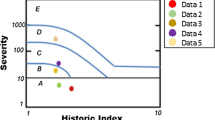Abstract
It is of great importance to investigate the effect of multiple loading rates on the crack propagation of brittle material such as concrete using acoustic emission because engineering structures are subjected to multiple loading conditions. Although material behaviour under single loading mode has been extensively studied, very limited research has been conducted to investigate the performance of brittle materials subjected to varying loading conditions. This paper presents an experimental study of the effects of single and multiple strain rates on cement mortar samples using acoustic emission. A total number of 81 concrete specimens were tested, in this 28 samples were tested in constant strain rate, whereas rest 53 samples were tested in multiple loading rates. Axial strain, lateral strain and acoustic emission counts were recorded continuously until the specimens had failed. The results showed that concrete behaves differently under multiple loading rates. Acoustic emission was in close agreement with the crack propagation and damage of concrete samples.

















Similar content being viewed by others
Abbreviations
- ε:
-
Strain
- AE:
-
Acoustic emission
- ωAB :
-
The acoustic emission cumulative damage parameter
- f c :
-
Crack damage threshold
- σ:
-
Axial stress
- N:
-
Accumulated number of AE
- C:
-
Integration constant
- a, b, m and B:
-
Empirical constants
- D:
-
Damage at the ultimate strength
- D0 :
-
Initial damage
- Dc :
-
Damage at ultimate strain
- A0 :
-
Threshold amplitude of the measuring system
- E:
-
Young’s modulus of a damaged material
- E* :
-
Young’s modulus of an intact material
- D:
-
Damage at the ultimate strength
- SR1:
-
Strain rate 1
- SR2:
-
Strain rate 2
- w:
-
Damage parameter
References
Bazant ZP, Planas J (1998) Fracture mechanics and size effect in concrete and other quasibrittle materials. CRC Press, New York
Beattie AG (1983) Acoustic emission, principles and instrumentation. J Acoust Emiss 2:95–128
Bischoff PH, Perry SH (1991) Compressive behavior of concrete at high strain rates. Mater Struct 24:425–450
Eberhardt E, Stead D, Stimpson B (1999) Quantifying progressive pre-peak brittle fracture damage in rock during uniaxial compression. Int J Rock Mech Min Sci 36:361–380
El Echary H, Mirmiran A (1998) Acoustic emission of retrofitted fibber-wrapped columns. SPIE 3400:106–117
Jones PG, Richart FE (1936) The effect of testing speed on strength and elastic properties of concrete. Proc Am Soc Test Mater 36(2):380–392
Karihaloo BL (1995) Fracture mechanics and structural concrete. Longman Scientific and Technical, New York
Khandelwal M, Ranjith PG (2013) Behaviour of brittle material in multiple loading rates under uniaxial compression. Geotech Geol Eng 31(4):1305–1315
Khandelwal M, Ranjith PG, Pan Z, Sanjayan JG (2013) Effect of strain rate on strength properties of low-calcium fly-ash based geopolymer mortar under dry condition. Arab J Geosci 6(7):2383–2389
Kipp ME, Grady DE, Chen EP (1980) Strain-rate dependent fracture initiation. Int J Fract 16:471–478
Komlos R (1964) Factors affecting the stress–strain relation of concrete in uniaxial tension. ACI J 66(2):111–114
Li X, Feng Z, Han G, Elsworth D, Marone C, Saffer D, Cheon DS (2016) Breakdown pressure and fracture surface morphology of hydraulic fracturing in shale with H2O, CO2 and N2. Geomech Geophys Geo-energ Geo-resour 2(2):63–76
Ohtsu M, Watanabe H (2001) Quantitative damage estimation of concrete by acoustic emission. Constr Build Mater 15(5–6):217–224
Ranjith PG, Jasinge D, Song JY, Choi SK (2008) A study of the effect of strain rate and moisture content on mechanical properties of concrete: Use of acoustic emission. Mechan Mater J 40(6):453–469
Shah SP (1983) Constitutive relations of concrete subjected to a varying strain rate. Proceedings of the symposium the interaction of nonnuclear munitions with structures, US Air Force Academy, Colorado, 81–84
Shah SP, Swartz SE, Ouyang C (1995) Fracture mechanics of concrete: applications of fracture mechanics to concrete, rock, and other quasi-brittle materials. John Wiley, New York
Singh B, Ranjith PG, Chandrasekharam D, Viete D, Singh HK, Lashin A, Al Arifi N (2015) Thermo-mechanical properties of Bundelkhand granite near Jhansi, India. Geomech Geophys Geo-energ Geo-resour 1(1):35–53
Uomoto T (1987) Application of acoustic emission to the field of concrete engineering. J Acoust Emiss 6:137–144
Van-Mier JGM (1997) Fracture processes of concrete. CRC Press, New York
Watanabe K, Niwa J, Iwanami M, Yokota H (2003) Localized failure of concrete in compression identified by AE method. Constr Build Mater 18(3):189–196
Weerheijm J, Reinhardt HW (1989) Modeling of concrete fracture under dynamic tensile loading. In: Shah SP, Swartz SE, Barr B (eds) Proceedings, symposium on fracture of concrete and rock: recent developments. Elsevier Applied Science, Cardiff, pp 721–728
Yang SQ, Xu P, Xu T (2015) Nonlinear visco-elastic and accelerating creep model for coal under conventional triaxial compression. Geomech Geophys Geo-energ Geo-resour 1(3):109–120
Zhao YS, Wan ZJ, Feng ZJ, Xu ZH, Liang WG (2017) Evolution of mechanical properties of granite at high temperature and high pressure. Geomech Geophys Geo-energ Geo-resour 3(2):199–210
Author information
Authors and Affiliations
Corresponding author
Rights and permissions
About this article
Cite this article
Khandelwal, M., Ranjith, P.G. Study of crack propagation in concrete under multiple loading rates by acoustic emission. Geomech. Geophys. Geo-energ. Geo-resour. 3, 393–404 (2017). https://doi.org/10.1007/s40948-017-0067-1
Received:
Accepted:
Published:
Issue Date:
DOI: https://doi.org/10.1007/s40948-017-0067-1




